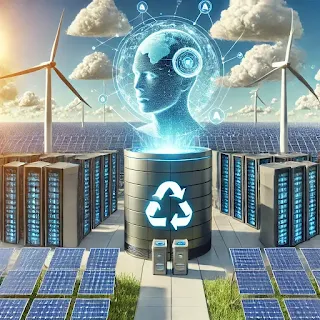Is AI Consuming Our Electricity? The Energy Crisis of Artificial. Intelligence
Introduction:
AI is revolutionizing industries, but at what cost? The rise of AI-powered data centers has led to massive energy consumption, sparking concerns about an AI-driven energy crisis.
I recently read that training a single AI model can consume as much electricity as hundreds of households in a year. This raises an important question—as AI continues to grow, will our power grids be able to handle the demand?
In this article, we’ll explore how AI impacts energy consumption, the challenges it creates, and potential solutions for a sustainable AI future.
1. The Energy Demand of AI: Why Is It a Concern?
AI systems, particularly deep learning models, require vast amounts of computational power to process data and make predictions. Training advanced models like OpenAI’s GPT-4 or Google's Gemini involves millions (or even billions) of calculations, consuming enormous amounts of electricity.
A recent study estimated that training a large AI model can consume as much energy as 50,000 U.S. homes do in a year. This level of energy consumption contributes to carbon emissions, raising concerns about AI’s long-term sustainability.
2. Data Centers: The Hidden Energy Guzzlers
Most AI processing takes place in massive data centers filled with high-performance servers. These facilities run 24/7, requiring constant cooling systems to prevent overheating.
Key Facts About Data Centers and AI Energy Use:
- The global data center industry consumes about 1% of the world's electricity.
- AI workloads are projected to increase data center energy demand by 30% in the next five years.
- Google’s AI division alone uses an estimated 15 terawatt-hours (TWh) annually, equivalent to the power consumption of a small country.
As AI adoption accelerates, the power demand for AI-driven computing will continue to grow, putting pressure on electricity grids worldwide.
3. The Environmental Cost: AI and Carbon Emissions
The high energy consumption of AI has direct environmental consequences. Many data centers still rely on non-renewable energy sources, contributing to greenhouse gas emissions.
A study from the University of Massachusetts found that training just one large AI model can produce as much CO₂ as five cars over their entire lifetime. This environmental cost raises ethical concerns about AI development and its impact on climate change.
Which AI Applications Consume the Most Energy?
- Chatbots & Virtual Assistants: Conversational AI models like ChatGPT require vast server resources.
- Facial Recognition Systems: Used in security and social media, these models run complex computations.
- AI-Powered Search Engines: Google’s AI-driven search algorithms require intensive data processing.
4. Can AI Become More Energy-Efficient?
While AI's energy consumption is a growing problem, researchers and tech companies are working on solutions to make AI greener.
Potential Solutions for Sustainable AI:
- Energy-Efficient AI Chips: Companies like NVIDIA and Google are developing specialized chips that consume less power.
- Renewable Energy-Powered Data Centers: Tech giants are investing in solar and wind energy to run AI models sustainably.
- Model Optimization: AI researchers are finding ways to train models using less computational power while maintaining accuracy.
For example, Meta (formerly Facebook) is designing AI systems that require 90% less energy than traditional models by using optimized algorithms.
5. The Future of AI and Energy Consumption
AI is here to stay, but if we want it to be a sustainable part of our future, energy efficiency must become a priority. Governments and tech companies must collaborate to ensure that AI advances without worsening the global energy crisis.
Key Takeaways:
- AI models consume massive amounts of electricity, leading to environmental concerns.
- Data centers are the primary contributors to AI-related energy demand.
- Renewable energy and energy-efficient hardware can help reduce AI’s carbon footprint.
- Sustainable AI development is essential for a greener future.
As AI continues to evolve, balancing technological progress with sustainability will be the key challenge.
Conclusion
The rise of AI is revolutionizing the world, but it comes with a hidden cost—energy consumption. Without proper management, AI could become one of the biggest contributors to global electricity demand. However, by investing in energy-efficient solutions and renewable resources, we can ensure that AI remains a powerful yet sustainable force for progress.













0 Comments